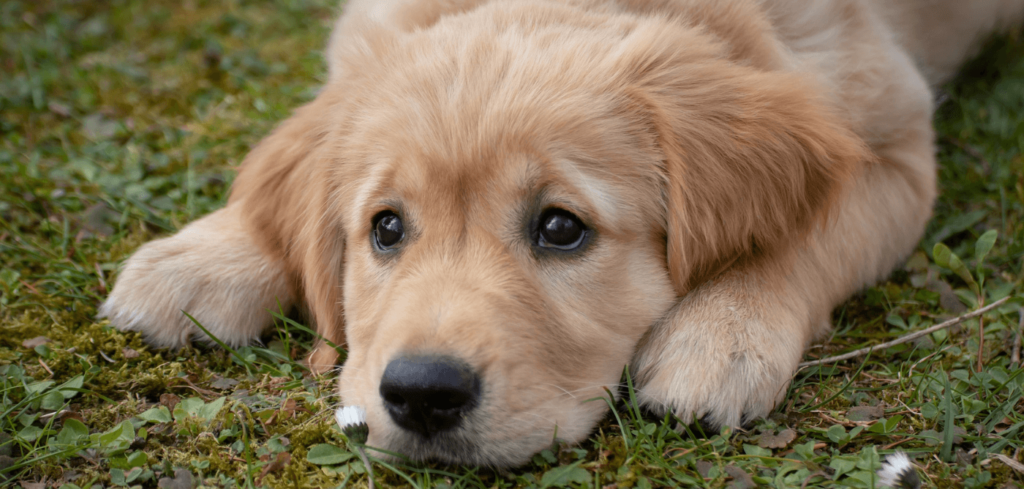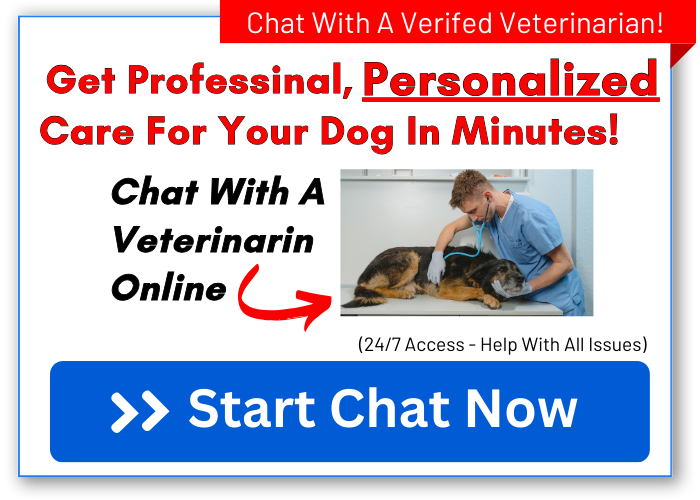
Our dogs are a part of our family, and it can be really upsetting to see them suffer…
Unfortunately, Canine Parvovirus is a reality and some of our pups do contract it, but what are the symptoms you’ll see from Parvo day by day…
How does it affect your dog? Will your dog be able to recover? What will life after parvo look like for your dog?
Well, in this article we’re going to answer those questions, and we’ll be doing it by going over the following information…
- What is Canine Parvovirus And How Do Dogs Get It?
- Is There A Parvo Vaccine?
- Parvo Day By Day – What Will Happen To Your Dog?
- Should I Force Feed My Dog With Parvo?
- Life After Parvo – How To Care For Your Dog At Home
In the end, you’ll know how to recognize if your dog has contracted Parvo and what you need to do to give your dog the best possible chance of survival…
Let’s begin by going over exactly what Parvo is…

What is Canine Parvovirus And How Do Dogs Get It?
Parvovirus is a deadly pathogen that is preventable when your dog has been properly vaccinated…
It is a highly contagious virus, and it can be spread to your dog through direct contact with another dog who has been infected…
…or indirectly if your dog comes into contact with an object that has been contaminated with the virus.

In addition to that, if your dog licks, sniffs, or even eats the feces of an infected dog, he will be exposed to the virus…
Indirect transmissions of the virus can happen when a person who has had contact with an infected dog touches your dog…
…or if your dog comes into contact with a contaminated object such as a collar, a leash, a toy, a sock, a water bowl, dog food, and even the clothes of a person.
The virus does the most damage to your dog’s stomach and small intestine. There is can impair absorption, destroy cells, and cause problems with your dog’s gut barrier…
It can also affect your dog’s bone marrow tissue, lymphopoietic tissue, and even his or her heart, and it’s a particularly deadly virus with up to an 80% fatality rate in young puppies.
Is There A Parvo Vaccine?
As I mentioned earlier, dogs can contract parvovirus directly from other dogs that are infected or by being exposed to a contaminated object…
The Parvovirus vaccine is available to protect your dog, and it’s considered one of the core vaccines that all puppies and adult dogs should have…
For puppies, there is a full series of 3 Parvo vaccinations which are administered at 8, 12, and 16 weeks of age…
(Puppies under six weeks of age often have some immunity to the parvovirus provided their mother was fully vaccinated prior to pregnancy.)
And for adult dogs, there are boosters that should be administered every 1 to 3 years. If your dog is not up to date on his or her vaccines or is too young for them, it’s a good idea not to take them out into public places…
If you’d like to discuss Parvovirus more with a veterinarian you can click the link below…

Parvo Day By Day – What Will Happen To Your Dog?
Every case of parvo differs in its intensity. However, if a secondary infection presents itself along with the symptoms of parvo, a dog’s chances of surviving drop tremendously…
If you suspect your dog has Parvo, get him or her to the vet as soon as possible. The earlier your dog has proper treatment, the better chance he or she has of survival…
Additionally, it is important to note that some breeds of dogs tend to be more susceptible to parvovirus…
These breeds include at least three Germanic breeds – the Rottweiler, the German Shepherd, and the Doberman Pinscher…
And other breeds that are more likely to develop an infection from parvovirus are English Springer Spaniels, Labrador Retrievers, and American Staffordshire Terriers…
There is no scientific evidence as to the reason why these dogs seem to be more susceptible to the illness…
Parvo Symptoms Day By Day…
Parvovirus symptoms usually present somewhere in the range of three days to one week after the initial exposure, and Parvovirus pathogens can live for up to a year…
Sometimes even the most observant of owners do not see symptoms until almost a week after exposure, which could leave other dogs in your home vulnerable as well…

In addition to that, neither extreme heat nor extreme cold can kill the virus, and typical household cleaners can have a hard time killing the virus as well…
So it’s extremely important to look for signs that your dog has Parvo to catch the virus early on…
And the following will give you a general idea of what you can expect to see in terms of Parvo symptoms day by day…
Parvo Day 1…
There are several early signs and symptoms that indicate that your dog might have Parvo. On day 1, you might notice that your dog has become lethargic…
In addition to that, your dog will begin vomiting and having repeated incidents of diarrhea, and both the vomit and diarrhea may have blood in them as well…
Also, your dog will have a loss of appetite and refuse to eat or drink, which will then lead to dehydration, and your dog will also probably develop a fever…
Owners have also reported that their dog’s eyes and mouth appeared red and inflamed, and your dog will often suffer from a rapid heartbeat and will appear to be in pain or discomfort…
Parvo comes on quickly. A dog may appear perfectly healthy one day, and the next day he may be violently vomiting and suffering from diarrhea…
Getting your dog to the vet as early as possible is critical to his survival because if your dog is not promptly treated for Parvo…
…things like dehydration, septic shock, and stress on your dog’s heart can cause death.

What Is The Treatment For Parvo?
Once parvo has been diagnosed, the vet will work to begin replacing fluids, vitamins, and minerals that have been lost via the severe vomiting and diarrhea that is common to a parvovirus infection…
This will be administered via intravenous fluids, and the vet will be monitoring, and you should expect your puppy to need to stay overnight – or longer – at the vet’s office for monitoring and treatment…
The vet will also provide medication that is meant to control the vomiting and upset stomach associated with the parvovirus infection…
Once your dog’s stomach issues are addressed, the vet will begin administering medications to eradicate any possible secondary infections that may present…
And the vet will also probably provide medications to control the pain your dog is experiencing as well…
Again, as most of these medications will need to be given intravenously, your dog will need to remain in the vet’s office or in an animal hospital, and you can expect your dog to stay for as long as seven days…

Dogs affected by the parvovirus infection typically cannot stay in their home, and this is due to the fact that dogs simply cannot keep any oral medications in their systems when the violent vomiting of the virus is not controlled…
It is reassuring, however, that dogs who are taken to their vet in time and receive treatment from their vet see a ninety percent survival rate…
Should I Force Feed My Dog With Parvo?
NEVER force feed your dog with Parvo…
The reason why is because your dog’s gastrointestinal tract is more than likely extremely irritated and stressed due to the vomiting and diarrhea that he is experiencing…
Later, once your dog is able to keep his food and water down, the vet may allow your do to return home…
Other Parvo recovery signs will include the vet looking to make sure that your dog is fully hydrated and eating solid food again.
Life After Parvo – How To Care For Your Dog At Home…
Once your dog is on the mend, you’ll be able to bring him or her home and hopefully, they’ll be able to make a full recovery…
That being said, dogs who are considered recovered from Parvo can still spread the virus for up to six weeks after they are considered “cured”…
Therefore, your vet will probably ask you to keep your recovering dog away from public places for at least one month…

And some vets will recommend a full six-week period of quarantine for dogs recovering from the infection…
You’ll also need to keep your dog away from other dogs in your household, and you’ll also want to do a thorough cleaning of your house because your dog may have contaminated much of it…
Also, keep in mind that Parvovirus is not easy to kill because it’s resistant to many common cleaners and disinfectants, and it can remain present for months…
Therefore, be sure to clean your house well using a 1 part bleach 10 times water solution or an Accelerated Hydrogen Peroxide…
Lastly, if there are any objects or materials that are not cleanable be sure to get rid of them so that no other dogs can become infected by them.

Final Thoughts…
Parvo is a deadly virus when left untreated, but if you catch it in the early stages and get your dog the right treatment…
…there is a high chance that he or she will be able to make a full recovery.
In addition to that, be sure that your dog is up to date on all his or her vaccines including for Parvo…
Doing this will help you avoid having to watch your dog suffer in the animal hospital, and it will keep him or her happy and healthy for a long time in the future.